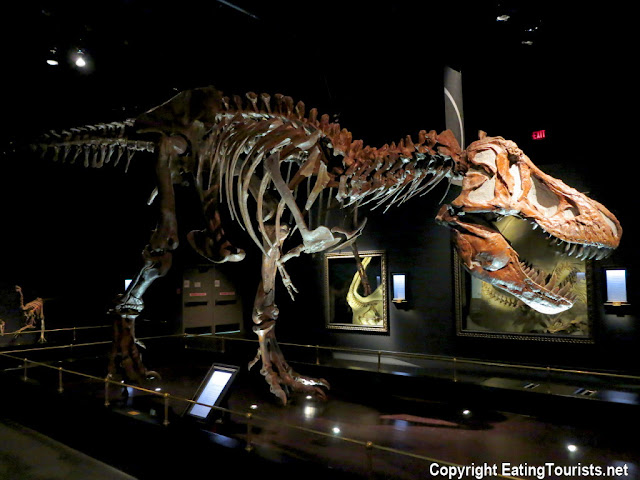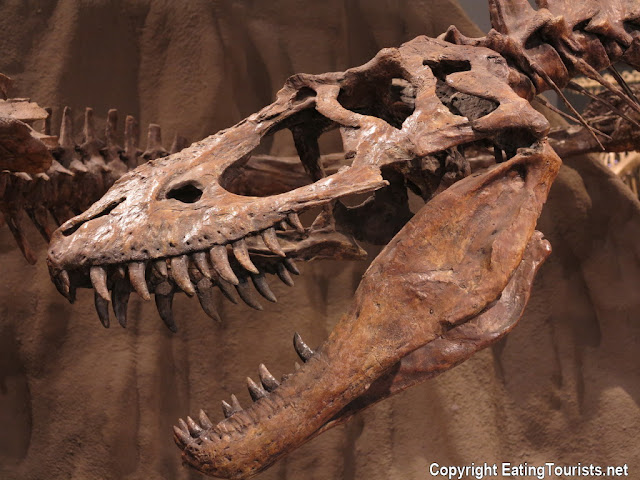It's unlikely that international visitors to Western Canada would miss an opportunity to visit what is likely the Mecca of the dinosaur world; the
. We first visited the museum in 1986 shortly after it opened. Back then it wasn't “Royal” yet, but it was still very impressive. Since we wanted to give the museum a chance to a add something new before we visited again, we hung on for about 30 years until we went back for another look, Sure enough, it was MUCH better this time, and worthy of the addition of the Royal appellation to the name.
 |
| The Royal Tyrrell Museum nestled in the badlands of Southern Alberta. |
Travelers that find themselves anywhere in the vicinity of the town of
Drumheller in the "badlands" of Southern Alberta would find it well worth their time to keep about 3 or 4 hours free for a trip back in time...way back. Admission is only $18 for adults, which would barely get you a burger and fries in a sit-down restaurant these days, and I guarantee you'll remember your day at Tyrrell long after you've forgotten a good burger.
 |
| Dramatic diorama-style staging of the first gallery gets you in the mood to learn more about this prehistoric world. |
The museum features ten galleries, and the first (Cretaceous Alberta) is brilliantly executed in a way that sets the stage and builds anticipation for the rest of your exploration of the 121,000 square feet of spectacular displays. It features an up close and personal meeting with our very own local cousin of the
T. Rex, the enormous top-of-the-food chain predator;
Albertosaurus.
 |
| In Cretaceous Alberta "objects in the mirror may be closer than they appear..." |
After you leave the “you are there” realism of the first gallery, we visit a well presented historical retrospective of the museum's development and the astounding and significant finds from the region.
 |
| One of the most important T. Rex skeletons ever found. |
While there are some special exhibits (like the
T. Rex shown above) that will change from time to time, there will be a similar gallery to gallery flow for future visitors. That flow is not random, and the thoughtful arrangement adds to the pleasure of exploring the museum.
 |
| Truly impressive Triceratops skull. |
We next get a look into the working “Preparations Lab” where you can see real work being done on the remains of these long dead creatures. If you've ever imagined yourself on your knees in the field as an archaeologist, scraping at an exposed dinosaur leg bone and then brushing away the sand with a fine paintbrush, the preparations lab will give you a look at how it
really happens.
 |
| The Preparations Lab, where the real work takes place. |
The next gallery, the “Lords of the Land” is in some ways the most beautiful and moving of them all. Here dinosaur bones are raised to the level of art, and are presented as such. This dark and beautiful room presents the displays as if they were sculptures or paintings, sometimes complete with frames. Here you will see a graceful and beautiful
Velociraptor that is literally “put up on a pedestal,” and while beautiful, you'll be glad that nobody has actually cloned them back to life as explored in “Jurassic Park.” (A nice creature to visit, but I wouldn't want them to live here.)
 |
| The beautifully displayed remains of Velociraptor are raised to the level of art. |
The gallery's centerpiece is J.B. Tyrrell's initial big find, the
Albertosaurus, and the gorgeous “Black Beauty,” a rare black colored skull of a
Tyrannosaurus Rex. (Note to geneticists: If you ever really do develop the ability to re-introduce these things...DON'T!)
 |
| Tyrrell's "big" find - Albertosaurus. |
Heading up the ramp to the second level, we move on to the “Burgess Shale” where we see an ingenious “all around you” depiction of the bizarre and almost alien creatures that lived in the area of the Canadian Rocky Mountains more than 500 million years ago. While generally fist-sized in their real lives, here we see them as many times that size in order to let us feel as if we are swimming among them in an ancient otherworldly sea. Even the floor is glass so we see the animals below us as if we were floating in the water above them.
 |
| The bizarre creatures of the "Burgess Shale" gallery. Hmm...maybe with a little garlic butter? |
A wonderful surprise to us was the small but beautifully crafted “Devonian Reef.” More a display than a gallery, it offers us a look at the underwater world of the Devonian period when the badlands of today were covered by an enormous tropical sea. Using a “dry for wet” technique, we get the benefit of seeing a most realistic presentation without any of the peskiness of having to deal with any actual water.
 |
| The "Devonian Reef" display is a realistic underwater scene. |
Scuba divers will note that the changes in the creatures that inhabit our world's reefs over the eons have been much less dramatic than those on land. They will also note that the museum did a good job of depicting what the surface of the ocean looks like when you're below it.
 |
| Prehistoric calamari. |
Small, but important, the "Terrestrial Paleozoic" gallery then takes you “...through over 200 million years in ten paces.” Covering the period during which life was moving out of the ocean and onto dry land, this part of Earth's past boasted dragonflies the size of actual dragons. (Well, not quite, but their wingspans were more than 2 feet).
 |
| A dragonfly the size of an eagle. |
Here a happy childhood memory was crushed when I learned that one of my favorite dinosaurs, the sail-backed
Dimetrodon wasn't even really a dinosaur at all, but a “mammal-like reptile.” However, without this guy, we might not have our dogs and cats today, as
Dimetrodon and his like gave rise to modern mammals. I wonder if it barked?
 |
| Dimetrodon's "sail" may have been for body temperature regulation - a combination solar panel & radiator. |
The next gallery, “Triassic Giant” offers the museum visitor a unique opportunity to walk around the remains of a truly enormous sea creature from our past, an
Ichthyosaur (properly known as “
Shonisaurus Sikanniensis”). Measuring 69 feet (21 meters) in length, the portion of the fossilized remains that were recovered are laid out on the floor atop a painted black outline of the original size and shape of the living creature.
 |
| This is how the "Triassic Giant" looked when it was still swimming around. |
This is the largest known marine reptile to have existed, and like the baleen whales of today, was a filter feeder. There is something about this cleverly designed room that underscores the true sense of scale when viewing this fossil that other galleries and displays do not. Despite its apparent simplicity it was a most memorable part of our visit.
 |
| The gallery provides a real sense of scale for the viewer. |
Easily missed near the exit to the “Triassic Giant” gallery is the entrance to a beautiful and restful tour through the “Cretaceous Garden.” A greenhouse of sorts, the garden features what is billed as “Canada's largest collection of prehistoric plant relatives.” This provides the viewer with an opportunity to imagine the desert-like landscape that surrounds the museum today as the lush, tropical, shallow sea and marshland that existed when the fossils showcased at Tyrrell lived and breathed. Even the pest control is all natural here, employing toads, salamanders, and ladybugs instead of ten-syllable chemicals. Don't miss this warm and humid walk through the past, especially if you're visiting during a cold time of year.
 |
| A "relative" of a prehistoric flower. |
The spectacular "Dinosaur Hall" is still...well....spectacular, and in some ways remains the central display area of the museum. The Hall lets the visitor place him or herself into the world of the dinosaur, at least for a while, and I'm glad that we never really co-existed, Hollywood “evidence” notwithstanding.
 |
| A "before and after" style display is common in the Dinosaur Hall. |
The feel of the room is starting to show its age, and it now has a nostalgic vibe that hearkens back to our childhood schoolroom ideas about what dinosaurs were all about. Back then, we kids stood on firm ground with what we “knew” about them (like my
Dimetrodon) and nobody could have shaken us from our confidence that there really was such a thing as a “
Brontosaurus.” I was heartbroken when we were later told that it was really just an
Apatosaurus all along. But hold on! Paleontologists have recently decided that our beloved childhood swamp-plant-muncher really
was a distinct creature after all. Yay
Brontosaurus! (I know how Pluto must have felt when it got demoted to “dwarf-planet” status...but I think they really prefer to be called “little-planets” these days. Maybe it will make a comeback as a
real planet too).
 |
| The guest can study these specimens very closely. |
Nestled in the center of Dinosaur Hall is the dark and beautiful “Marine Hall.” In this gallery, the skeletons of enormous sea creatures cavort and swirl around us and overhead in a display that cleverly gives a sense of being undersea and at the very center of the action. Sort of like what a diver feels in a swirling mass of reef fish, but if the fish were all twenty feet long and had teeth like crocodiles.
 |
| "We need a bigger boat..." |
Now we had back toward the present day as we enter the “Ice Age.” Here, despite the Arctic setting, the creatures are more familiar, looking more like alternate reality versions of elephants, bison, and cougars. Familiar or not, I'm glad that it's a deer that we risk hitting on the highway these days instead of a ten foot tall, 8 ton, woolly mammoth.
 |
| If those cats pull this off...they'll eat like kings! |
Our final stop before returning to the present is “Mammal Hall.” While mammals actually developed right alongside dinosaurs, they were mostly small creatures (and
really scared...ALL the time) until dinosaurs met their still somewhat mysterious demise. With the ecological niche cleared by the absence of all those twenty-five foot tall meat eating monsters, mammals had a chance to get bigger...much bigger. Our own early ancestors were probably pretty happy to have access to a herd of slow, docile, plant eaters from which they could obtain a decent steak.
 |
| I'm bettin' there'd be a few good roasts on that guy...just sayin'... |
Finally, inevitably, we complete our journey through the incredible history of our planet in the time honored fashion that has itself been passed down through the ages as we “exit through the gift shop.” If you can't find an appealing souvenir widget or thing-a-ma-bob in here to put on your desk or hang from your rear-view mirror, it's really your own fault. Beware those of you that bring small children. This place is chock-a-block with plastic toy dinosaurs of every shape, size, and type, so make sure you have plenty of room on your credit card. As for me...hmmm...I like those speckled blue “Tyrrell Logo”
bistro style coffee mugs...and we really ought to have some little memento...”Vicky!...Honey!...What do you you think of these?...”
Fox & Vicky






















No comments:
Post a Comment